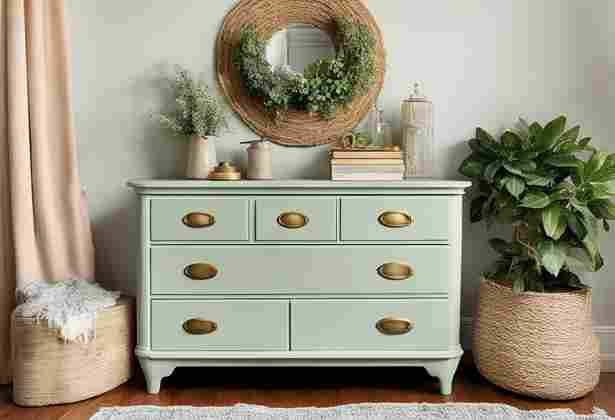American decor blends tradition, creativity, and comfort. From rustic farmhouse to sleek modern, every style tells a unique story. People across the United States embrace these designs to create spaces that feel personal and inviting.
American decor reflects the nation’s diverse history. Colonial homes introduced timeless wood furniture. Later, industrial lofts highlighted raw materials and open layouts. Today, you can mix both old and new for balance and warmth. As a result, homes showcase individuality while staying practical. Because styles vary widely, American decor offers flexibility. You might favour vintage charm with folk art, or choose clean lines with minimalist influence. Even small choices, like fabrics or colors, can shift a room’s mood. This versatility helps homeowners craft spaces that spark joy and welcome guests.
In this blog, we will explore different American decor styles. You’ll see how each carries its own character, whether classic, rustic, or modern. Along the way, you’ll discover ideas to bring these elements into your home. Ultimately, American decor shows how design can merge beauty and meaning in everyday life.
Farmhouse Style in American Decor
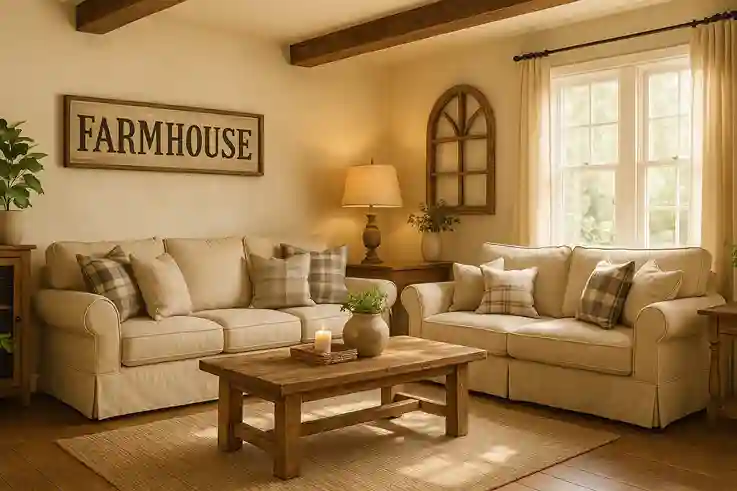
Farmhouse style in American decor feels warm, simple, and timeless. It draws from rural traditions where practicality shaped design. Wood, stone, and natural fabrics remain central to this approach.
Because farmhouse homes once relied on durable materials, the look emphasizes function. Wide plank floors, exposed beams, and sturdy tables still define the style. Over time, these elements shifted from necessity to design choice, yet they keep their rustic charm. Farmhouse style also values comfort. Neutral colors, soft textures, and open spaces create a sense of calm. Adding vintage finds, such as weathered signs or antique cabinets, enhances the inviting atmosphere. Even small touches, like woven baskets or cotton curtains, make rooms feel lived-in and personal.
Today, farmhouse style often blends with modern elements. Sleek fixtures, clean lines, and brighter palettes refresh traditional features. As a result, homes achieve balance between classic character and contemporary ease. This mix allows flexibility, whether you live in the countryside or a city apartment.
Ultimately, farmhouse style in American decor celebrates simplicity and authenticity. It shows how everyday materials can become beautiful when paired with thoughtful design.
Industrial Style in American Decor
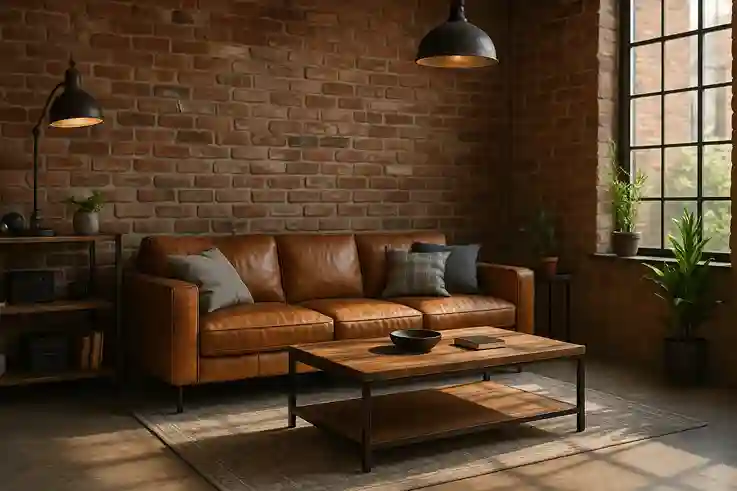
Origins of Industrial Style
Industrial style in American decor began in factories and warehouses of the late 19th and early 20th centuries. These buildings focused on work efficiency, not beauty. Brick walls, steel beams, concrete floors, and tall windows all served practical purposes. As industries shifted, many factories closed or moved. Large empty buildings stood unused in American cities. Later, people began converting those spaces into homes, studios, and lofts. Because the structures were strong and open, they offered flexibility for living.
Instead of covering rough surfaces, designers chose to celebrate them. Exposed brick, pipes, and ductwork became design statements. High ceilings and wide layouts gave rooms a sense of freedom. Over time, this practical reuse grew into a recognizable American decor style.
Industrial style carries history into modern homes. It reflects the nation’s working past while offering bold character and simplicity.
Defining Features
Exposed brick, steel beams, and concrete floors give industrial style its core identity. These materials were never meant to impress. Instead, they were chosen for strength, cost, and ease of construction. Because workers and owners never covered them, the raw surfaces stayed visible. Later, designers saw beauty in that honesty. Brick added warmth and texture, while steel beams gave bold lines and contrast. Concrete floors, though simple, provided durability and a clean foundation.
Large windows became another defining feature. Originally, factories needed natural light for workers. Today, those wide panes brighten homes and highlight open spaces. Open layouts also trace back to the factory floor. With few walls, the spaces allowed machines and workers to move freely. In modern homes, that same openness creates flexibility and flow. As a result, industrial style feels both raw and expansive.
Function Meets Beauty
Industrial style in American decor always begins with function. Early factories used strong materials because they lasted, not because they looked attractive. Metal furniture, reclaimed wood tables, and simple lighting fixtures were chosen to serve workers efficiently. Because these items were practical, they avoided ornament. Straight lines, strong frames, and unpolished finishes kept them sturdy and low-maintenance. Yet, when viewed in a home, the same qualities create striking visual impact.
Reclaimed wood tables show the marks of time. Scratches, knots, and weathered tones bring depth and authenticity. Metal chairs and cabinets reflect strength and resilience. Even a bare light fixture, once used only for utility, now feels stylish through its simplicity.
When paired together, these pieces balance one another. Warm wood softens cold steel. Simple lighting enhances rough brick walls. As a result, a space that values utility alone transforms into one that carries beauty through honesty.
Adding Warmth
Industrial style in American decor can sometimes feel stark. Concrete floors, steel beams, and bare walls create a cool atmosphere. To avoid coldness, people introduce warmth through thoughtful details. Rugs are often the first choice. Their textures soften hard floors and add comfort underfoot. Natural fibers, such as wool or jute, pair especially well with industrial spaces because they echo raw honesty.
Plants bring life and color into otherwise neutral rooms. Greenery contrasts against gray walls and metal frames, adding freshness. Even a few potted plants can shift the energy of a space. Textiles, including throws, cushions, and curtains, also help balance the style. Soft fabrics add layers of coziness while muting echoes from wide, open layouts.
Vintage pieces deepen the character. Old lockers, weathered stools, or repurposed factory carts remind us of the style’s origins. Because these items carry history, they strengthen the connection to industrial roots while making rooms more personal.
Through these touches, industrial decor stays raw yet inviting. Warm accents soften edges without losing the style’s bold identity.
Modern Adaptation
Today, industrial style in American decor extends far beyond old factories. It works well in lofts, studios, and modern homes. Because open layouts remain popular, the industrial aesthetic adapts easily to contemporary living. In cities, loft apartments often highlight original brickwork and exposed pipes. These spaces embrace industrial roots while offering modern convenience. In suburban homes, designers recreate the look by adding steel light fixtures, reclaimed wood shelving, or polished concrete accents. Even small details, like metal-framed mirrors or Edison bulbs, bring the style into everyday spaces.
Industrial decor also blends smoothly with other American styles. With farmhouse, it creates a rustic-meets-urban feel that balances softness and strength. With contemporary, it sharpens clean lines while maintaining warmth. This flexibility makes it appealing for homeowners who want both tradition and modernity. Ultimately, industrial style proves that raw materials can feel refined. Brick, steel, and wood tell stories of labour and history, yet they inspire beauty when reimagined for today’s homes. It is a style that honors the past while shaping spaces for the future.
American Southwest Style
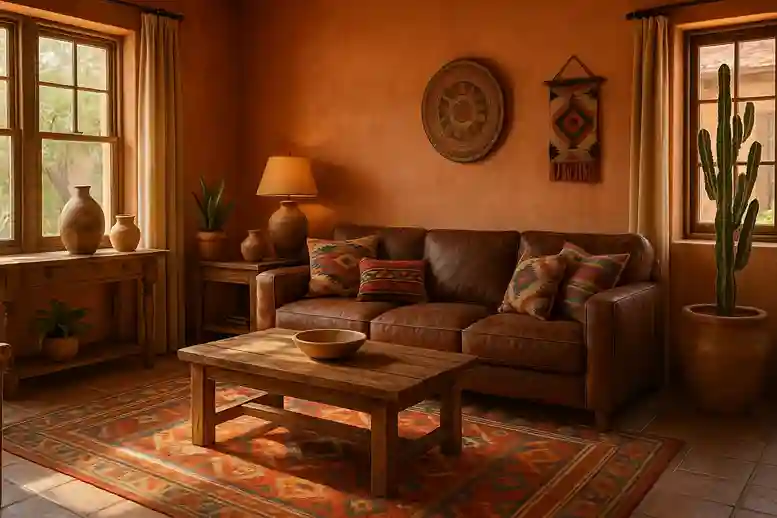
Origins of Southwest Style
American Southwest style in decor draws from Native traditions, Spanish influence, and desert landscapes. This mix began in the arid regions of Arizona, New Mexico, and Texas. Adobe homes, clay floors, and handwoven textiles reflected the environment and culture. Over time, these features blended into a distinctive style that still feels rooted in place.
Defining Features
Earth tones dominate the Southwest palette. Warm shades of terracotta, sand, and clay mirror the desert. Bold accents, such as turquoise and deep red, add energy. Materials like wood, leather, and wrought iron create strength and authenticity. Geometric patterns, especially those inspired by Native weaving, appear on rugs, blankets, and pottery.
Function and Comfort
The style emphasizes practicality. Thick adobe walls kept homes cool in summer and warm in winter. Open courtyards allowed airflow, while heavy wooden doors protected from heat. Today, these functional elements appear as design choices that also provide comfort.
Adding Warmth
Textiles play a central role. Handwoven blankets, colorful rugs, and embroidered cushions soften adobe or stone walls. Natural accessories, including clay pots or carved wood, add layers of warmth. Plants like succulents and cacti connect interiors to the surrounding desert.
Modern Adaptation
Today, Southwest style moves easily into urban or suburban homes. Neutral walls pair with bold patterned textiles for balance. Rustic wood furniture mixes with modern lighting to create contrast. Because the style values natural beauty, it blends well with minimalist or bohemian influences. Ultimately, American Southwest decor celebrates landscape, history, and culture in every detail.
Traditional Colonial Style
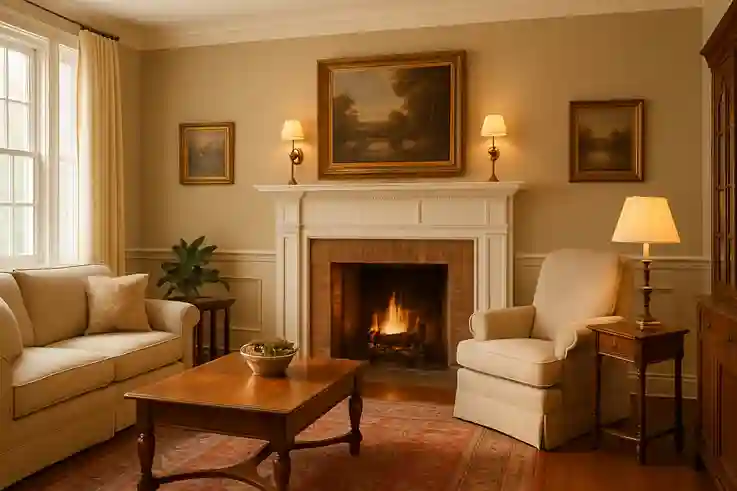
Origins of Colonial Style
Traditional Colonial style in American decor dates back to the 17th and 18th centuries. Early settlers built homes with European influence, often borrowing from English, Dutch, and Spanish traditions. Because resources were limited, they relied on simple forms, sturdy materials, and practical layouts. These choices laid the foundation for a design style that still feels timeless today.
Defining Features
Colonial homes emphasize symmetry. Windows, doors, and chimneys often align in balanced patterns. Wood is the primary material, seen in floors, beams, and paneled walls. Fireplaces stand as central features, both for warmth and for gathering. Classic colors like deep reds, blues, and creams add richness. Decorative moldings, brass fixtures, and simple textiles complete the look.
Function and Practicality
Early Colonial design valued function above all else. Furniture included strong wood tables, ladder-back chairs, and storage chests. Each piece served a purpose while reflecting craftsmanship. Because homes were multi-use spaces, layouts remained simple and efficient.
Adding Warmth
Even with structure and symmetry, Colonial interiors feel warm. Woven rugs, hand-stitched quilts, and patterned curtains soften the rooms. Candlelight or lantern-inspired fixtures add glow. Natural textures like wool and linen connect the space to its historic roots. These touches keep the decor inviting instead of formal.
Modern Adaptation
Today, Colonial style adapts to both historic and new homes. Designers often combine traditional features with modern updates. For example, open kitchens may still feature wood beams or paneled cabinetry. Neutral walls balance against rich wood floors, while brass hardware nods to tradition. Because it blends history with elegance, Colonial style remains one of the most enduring forms of American decor.
Boho Americana Style
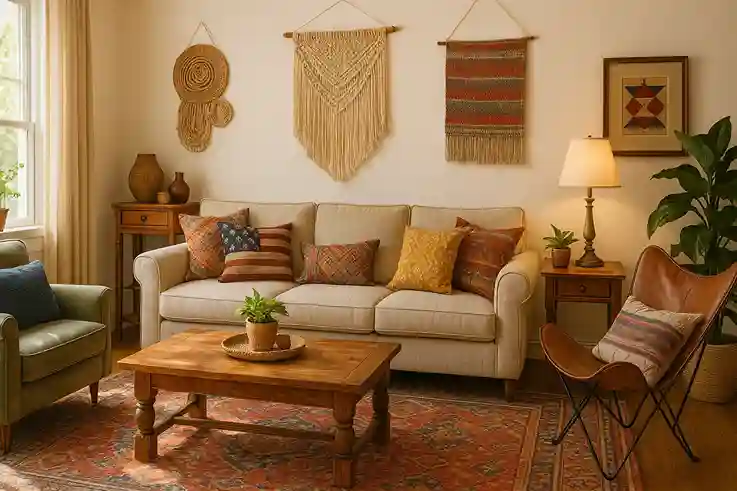
Origins of Boho Americana
Boho Americana style blends the free-spirited bohemian look with classic American elements. It draws inspiration from the 1960s counterculture movement and layers it with folk art, vintage finds, and regional crafts. Because it celebrates individuality, no two spaces look the same. The result is a style that feels relaxed, eclectic, and deeply personal.
Defining Features
Boho Americana thrives on mix and match design. Colorful textiles, patterned rugs, and macramé wall hangings bring vibrancy. Folk art, quilts, and handmade pottery highlight American craft traditions. Vintage pieces, whether weathered trunks or repurposed chairs, add authenticity. Layered textures—from woven baskets to fringe pillows—create depth and comfort.
Function and Comfort
Although eclectic, the style values comfort. Overstuffed chairs, floor cushions, and low tables invite relaxation. Open shelving displays books, plants, and collected treasures. Because functionality blends with creativity, homes feel lived-in and welcoming.
Adding Warmth
Natural elements strengthen the boho vibe. Plants soften corners and add life to neutral walls. Wood furniture, wicker accents, and stone details ground the space. Quilts or handwoven throws bring warmth while also honoring Americana heritage. Small touches, such as candles or lantern-style lights, add cozy glow.
Modern Adaptation
Today, Boho Americana suits apartments, cottages, and family homes. It pairs easily with farmhouse or Southwest styles, adding creativity without losing tradition. Neutral backgrounds often serve as canvases for bold art and colorful textiles. Ultimately, Boho Americana style reflects freedom, individuality, and comfort—all central to American decor.
Lodge & Cabin Style in American Decor
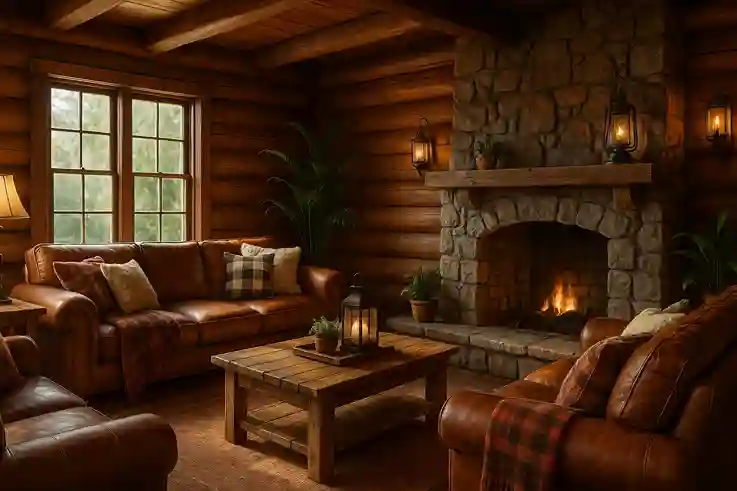
Origins of Lodge & Cabin Style
Lodge and cabin style in American decor grew from life in the mountains and forests. Early settlers built cabins with logs and stone because those materials were abundant. Later, hunting lodges and vacation retreats carried the same rugged look. This style connects directly to nature, reflecting both survival and relaxation in wild landscapes.
Defining Features
Natural materials define the look. Log walls, stone fireplaces, and timber beams create strength and warmth. Leather chairs, wool blankets, and fur throws emphasize comfort. Colors follow the outdoors—deep browns, greens, and grays mixed with warm reds and golds. Large fireplaces serve as the centerpiece of many rooms.
Function and Practicality
Because cabins were built for tough conditions, the style values durability. Furniture is heavy and solid, often handcrafted. Storage pieces like wooden chests and built-in shelving maximize space. Lighting tends to be simple, with lantern-style fixtures or wrought iron accents. Every item feels both useful and long-lasting.
Adding Warmth
Textures soften the rugged bones of a cabin. Plaid blankets, braided rugs, and handwoven curtains make the space inviting. Antlers, carved wood, and rustic art add character. Large windows open views to nature while pulling in light, which balances the darker tones of wood and stone.
Modern Adaptation
Today, lodge and cabin style fits vacation homes, suburban houses, and even city lofts. Designers often pair rustic logs with modern amenities for balance. For example, a sleek kitchen might sit beside a stone fireplace. Because the style embraces nature, it blends well with eco-friendly choices and outdoor living spaces. Ultimately, lodge and cabin decor celebrates warmth, strength, and the American love of the outdoors.
Mid-Century Modern Style in American Decor
Origins of Mid-Century Modern
Mid-Century Modern style in American decor emerged after World War II. Designers responded to a growing middle class that wanted affordable, stylish homes. Influenced by European modernism, the movement embraced simplicity, open spaces, and new materials. Because it reflected optimism and progress, the style quickly spread across the United States.
Defining Features
Clean lines define Mid-Century Modern furniture. Low-slung sofas, tapered legs, and streamlined tables create balance without clutter. Materials include molded plastic, plywood, and glass, alongside traditional wood. Large windows connect interiors to nature, while open floor plans emphasize flow and light.
Function and Practicality
The style values function above decoration. Each piece serves a clear purpose while maintaining elegance. Furniture is lightweight, easy to move, and designed for daily living. Storage solutions, such as credenzas and wall units, combine beauty with utility. Because every detail supports comfort, homes feel modern yet approachable.
Adding Warmth
Although sleek, Mid-Century Modern interiors never feel cold. Warm woods, especially walnut and teak, add richness. Textiles, such as geometric rugs or bold cushions, introduce color. Artwork, ceramics, and sculptural lighting bring personality. These details soften minimal forms while keeping the clean aesthetic intact.
Modern Adaptation
Today, Mid-Century Modern style remains one of the most popular choices in American decor. Original pieces are highly sought after, but reproductions make the look accessible. It pairs easily with contemporary or bohemian styles, allowing flexibility. Ultimately, Mid-Century Modern continues to thrive because it offers timeless simplicity, functionality, and beauty that fit today’s lifestyles.
Patriotic Americana Style
Origins of Patriotic Americana
Patriotic Americana style reflects pride in American history and values. It began with colonial-era traditions and grew stronger during times of national unity. Folk art, handmade quilts, and flags became symbols of identity. Over time, these elements shaped a style that celebrates heritage while honoring everyday life.
Defining Features
The American flag often stands at the center of this style. Stars, stripes, and bold red, white, and blue dominate color choices. Distressed wood furniture, vintage signs, and weathered finishes add authenticity. Decor items such as tin stars, barn quilts, and old maps reinforce the historical theme.
Function and Practicality
Patriotic Americana decor balances symbolism with utility. Wooden chests, ladder-back chairs, and sturdy tables provide function while carrying classic American forms. Textiles, including hand-stitched quilts and woven rugs, serve daily needs but also tell cultural stories. Because the style values tradition, every piece feels both meaningful and useful.
Adding Warmth
Folk art and handmade details bring charm. Painted signs, woven baskets, and pottery add human touch. Candles and lantern-style lights soften the space with warmth. Antique finishes, combined with natural materials like wood and iron, create an inviting, lived-in atmosphere.
Modern Adaptation
Today, Patriotic Americana appears in country homes, farmhouses, and even urban apartments. Designers often blend the traditional red, white, and blue palette with neutrals for balance. Small accents, such as flag pillows or framed historic prints, keep the theme subtle yet powerful. Ultimately, Patriotic Americana style in American decor connects past and present, celebrating national pride in everyday living spaces.
“Apartment Therapy highlights that farmhouse design relies on neutral palettes, raw materials, lived-in textures, and welcoming furniture—all key to capturing the timeless warmth of American farmhouse decor.”
FAQs on American Decor
Conclusion
American decor reflects the nation’s history, culture, and creativity. From farmhouse warmth to industrial edge, every style tells a story. Colonial homes, Mid-Century designs, and Southwest influences all show how tradition blends with innovation. Because these styles are flexible, they adapt to any home. A rustic lodge can feel modern with simple updates. A boho apartment can carry folk art alongside sleek furniture. Even patriotic details, like quilts or flags, add character without overwhelming a room.
Ultimately, American decor is about more than design. It is about creating spaces that feel personal, welcoming, and meaningful. Whether you choose rustic, modern, or eclectic, each choice connects you to a wider tradition. By embracing these styles, you bring history, comfort, and individuality into your everyday life.
Which American decor style inspires you most? Share your favourite—farmhouse, industrial, Southwest, or another—in the comments below!

Silvia Heart is a lifestyle and wellness writer with a background in apparel and a degree in fashion. She blends creativity with practical insights, guiding readers toward intentional, balanced living. Through her approachable style and thoughtful storytelling, Silvia inspires her community to embrace both everyday joy and personal growth.


